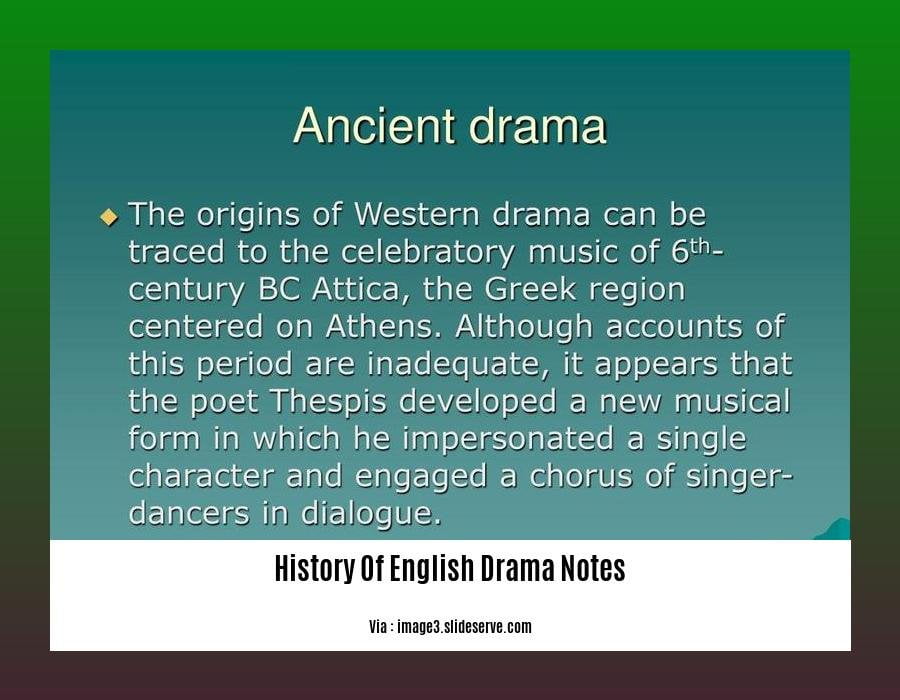Step into the captivating world of English drama as we embark on a journey through the ages, from the medieval mystery plays to the Victorian era. Experience the evolution of dramatic forms, uncover the socio-cultural influences that shaped theatrical productions, and delve into the impact of key playwrights on the development of the English stage. Join us as we unveil the rich history of English drama in “Unveiling the History of English Drama: A Journey Through the Ages [history of english drama notes].”
Key Takeaways:
Drama has its roots in religious ceremonies and annals.
The Elizabethan era witnessed the rise of distinct stages in drama, driven by entertainment and religious expression.
The classical drama influenced English drama, introducing five acts, set scenes, and the division into comedies and tragedies.
English drama evolved after 1610, with improvements in technical skill, exposition handling, and climax building.
The exact origins of drama are uncertain, but it is believed to have entered England after the Norman Conquest in 1066.
The History of English Drama: A Journey Through the Ages [history of english drama notes]

In the vibrant tapestry of English literature, drama holds a prominent place, reflecting society’s ever-evolving cultural landscape. Its roots trace back to ancient religious rituals, weaving together elements of storytelling, music, and dance.
The Middle Ages witnessed the emergence of mystery plays, morality plays, and miracle plays, staged during religious festivals. These early forms of drama, often performed in churches or town squares, conveyed moral lessons and celebrated biblical narratives.
The Renaissance, a period of intellectual and artistic resurgence, ushered in groundbreaking changes to English drama. Playwrights like William Shakespeare, Christopher Marlowe, and Ben Jonson crafted masterpieces that continue to captivate audiences worldwide. Their plays explored universal themes of love, loss, ambition, and the human condition.
During the Restoration era, the theater underwent a transformation, influenced by continental trends. Women graced the stage for the first time, theaters became more elaborate, and heroic tragedies and comedies flourished.
The 18th century saw the rise of sentimental dramas and satirical comedies, reflecting the social and political climate of the time. Playwrights like Richard Brinsley Sheridan and Oliver Goldsmith entertained audiences with witty wordplay and social commentary.
The 19th century brought forth a fascination with historical dramas, influenced by the Romantic movement. Playwrights like William Wordsworth, Samuel Taylor Coleridge, and Lord Byron explored themes of nature, imagination, and individual freedom.
The 20th century witnessed a surge of experimental theater, challenging traditional forms and pushing boundaries. Playwrights like Bertolt Brecht, Samuel Beckett, and Harold Pinter revolutionized the stage with innovative techniques and unconventional narratives.
In contemporary times, English drama continues to evolve, embracing diversity, multimedia, and global perspectives. Playwrights explore pressing social issues, celebrate cultural heritage, and connect with audiences in new and exciting ways.
As we delve into the history of English drama notes, we’re not just studying dusty manuscripts; we’re embarking on a journey through time, witnessing the evolution of thought, expression, and human experience. Each era, each playwright, each performance leaves an indelible mark on the rich tapestry of English drama.
Discover the captivating chapters of history of English literature periods as it unravels the evolution of wordsmiths. Explore the rich tapestry of English literature, from its humble origins to its dazzling heights, in our comprehensive history of English literature summary. Embark on a sartorial odyssey through time with our exploration of the history of fashion in the Philippines.
17th and 18th centuries

After the turbulent years of the Puritan rule, the Restoration period (1660-1714) marked a revival of theater in England. This era witnessed the rise of the Restoration comedy—a genre characterized by its witty dialogue, satirical humor, and risqué themes. Playwrights like William Wycherley, George Etherege, and William Congrevecrafted comedies that explored the complexities of Restoration society, often poking fun at its excesses and hypocrisies.
The 18th century brought about significant social and political changes that greatly influenced the theatrical landscape. The rise of the middle class, the expansion of the British Empire, and the growing influence of Enlightenment ideas all contributed to the evolution of drama during this period. Playwrights such as Oliver Goldsmith and Richard Brinsley Sheridan explored themes of class conflict, social justice, and political corruption in their works, reflecting the changing values and concerns of society.
Key Takeaways:
The Restoration period witnessed a resurgence of drama with the rise of the Restoration comedy, characterized by its wit, satire, and exploration of Restoration society’s complexities.
The 18th century saw the rise of a new generation of playwrights who explored themes of class conflict, social justice, and political corruption, capturing the changing values and concerns of society.
The Restoration and 18th-century drama played a crucial role in shaping the development of English theater, influencing genres and themes that would continue to resonate in later periods.
Sources:
[1] Hume, Robert D. “The Development of English Drama in the Late Seventeenth Century.” JSTOR, 1974.
[2] “Restoration and 18th Century English Drama.” Drama Online, n.d.
Victorian era
The Victorian era brought forth significant transformations in the world of English drama, leaving a lasting impact on the theatrical landscape. Let’s explore the key highlights of this period:
The Kemble Family: Trailblazers of the Stage
- John Philip Kemble and Sarah Siddons, renowned siblings, captivated audiences with their exceptional acting skills, cementing their status as theatrical legends.
- Their command of the stage and emotional intensity set new standards for dramatic performances.
Edmund Kean: The People’s Favorite
- A charismatic and enigmatic figure, Edmund Kean challenged the dominance of the Kemble family, becoming a popular favorite with his electrifying performances.
- Kean’s portrayal of Shakespearean characters, particularly Shylock and Hamlet, earned him widespread acclaim.
19th-Century Spectacle: Dazzling Audiences
- Technological advancements revolutionized theatrical productions, introducing elaborate sets, special effects, and innovative lighting techniques.
- These “sensation” dramas, blending visual spectacle with melodrama, captivated audiences and redefined the possibilities of theater.
Melodrama: A Moralistic Triumph
- Melodrama flourished during the Victorian era, gripping audiences with its exaggerated emotions, larger-than-life characters, and clear-cut moral lessons.
- These plays explored social issues, highlighting the struggles of the working class and the moral dilemmas of the upper classes.
Key Takeaways:
- The Victorian era witnessed a shift in theatrical focus, moving from Shakespearean repertoire to more contemporary and socially relevant themes.
- Technological advancements dramatically enhanced the visual spectacle of theatrical productions.
- Prominent figures like the Kemble family, Edmund Kean, and other renowned actors shaped the era’s theatrical landscape.
- Melodrama emerged as a popular genre, capturing the Victorian fascination with moralistic tales and addressing social issues.
Sources:
- 19th Century Drama and Theatre – Victorian Era
- 19th-Century Theatre Facts: Curious Stage Plays Details
FAQ
Q1: What were some key features of the Elizabethan and Jacobean periods in English drama?
A1: The Elizabethan and Jacobean periods were marked by the rise of professional theater companies, the development of new genres such as history plays and comedies of manners, and the emergence of some of England’s most famous playwrights, including William Shakespeare.
Q2: How did the English drama change after the Restoration in 1660?
A2: After the Restoration, English drama became more secular and less didactic, reflecting the rise of a new, more cosmopolitan audience. New types of plays, such as the Restoration comedy, emerged, and women were finally allowed to perform on the English stage.
Q3: What were some of the major themes explored in 18th-century English drama?
A3: The 18th century was a time of great social and political change in England, and this was reflected in the drama of the period. Major themes explored in 18th-century English drama include class, gender, and politics.
Q4: What were some of the most popular forms of theater in the Victorian era?
A4: Some of the most popular forms of theater in the Victorian era included melodrama, sensation dramas, and burlesque. Melodrama was a popular form of theater that featured exaggerated emotions, heroes and villains, and a strong moral message. Sensation dramas were a type of play that relied heavily on special effects and spectacle to create a sense of excitement and suspense. Burlesque was a type of theater that parodied or satirized other forms of drama.
Q5: Who were some of the most famous actors of the 19th century?
A5: Some of the most famous actors of the 19th century include John Philip Kemble, Sarah Siddons, and Edmund Kean. Kemble and Siddons were celebrated actors who were considered among the finest in theater during the early 19th century. Kean replaced Kemble as the popular favorite after his Drury Lane debut as Shylock in 1814.
- Senior at What Age: Benefits & Eligibility Guide - March 29, 2025
- Unlocking Senior Benefits: How Old is a Senior? Your Complete Guide - March 29, 2025
- Master Russian Politeness:A Guide to Saying Please - March 29, 2025
















